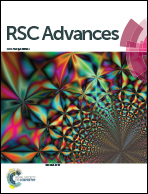Hydrothermal synthesis of MoS2 nanosheet loaded TiO2 nanoarrays for enhanced visible light photocatalytic applications
Abstract
A molybdenum disulfide (MoS2) nanosheet-decorated titanium dioxide (TiO2) NRA heterojunction composite was fabricated successfully through a two-step hydrothermal approach. Microstructures and optical properties of specimens were characterized by field-emission scanning electron microscopy, X-ray diffractometry, X-ray photoelectron spectroscopy, and ultraviolet-visible spectroscopy. The gaps of the TiO2 nanorods have been filled with tiny MoS2 nanosheets, which can increase the surface area of MoS2/TiO2 NRA composite thin films. In addition, the photocatalytic activity of the thin films were measured and discussed in greater detail. The appropriate hydrothermal reaction temperature of MoS2 is important for the growth of perfect MoS2/TiO2 NRA composites with significantly enhanced photocatalytic performance. The photodegradation rate and k value of MoS2-220/TiO2 are 86% and 0.0105 min−1, respectively, which are much larger than those of blank TiO2. The enhanced photocatalytic performance could be attributed to the higher visible light absorption and the reduced recombination rate of photogenerated electron–hole pairs.



 Please wait while we load your content...
Please wait while we load your content...